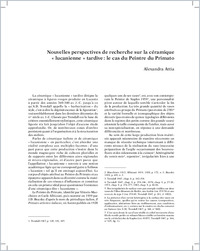Nouvelles perspectives de recherche sur la céramique « lucanienne » tardive : le cas du Peintre du Primato
BHAP-HA+SCANT
- Attia, Alexandra ORCID Université de Fribourg
- Zenodo, 2022
Published in:
- La Lucanie entre deux mers. Archéologie et patrimoine, Actes du Colloque international (Paris, 5-7/11/2015) / Cazanove, Olivier de ; Duplouy, Alain. - Naples. Centre Jean Bérard . - 2022, p. 821-825
Iconographie
Céramique lucanienne
Vases à figures rouges
Peintre du Primato
Lucanie
Peintre de Lycurgue
English
No in-depth study had been conducted on these vases, produced in Lucania around the second half of the 4th century BC. until its so-called “barbarization” presumably occurring in the last decades of that same century, since Trendall's stylistic classification in 1967. Thanks to a methodological and multidisciplinary study, this book provided a critical review of the data associated to the Late Lucanian red-figured vases to overcome the persistent questions regarding the location and articulation of these workshop productions. To do so, the numerous recent archeological finds in Basilicata and Puglia were gathered and added to the initial stylistic corpus in an updated inventory. The main goal was to provide new approaches informed by contextual archaeology and archaeology of production. Through an integrated analysis of iconographic, stylistic, morphological, technological and contextual aspects, this study restores to ceramics its role as a useful document for clarifying aspects of the history, mentality and culture of Magna Grecia. New archaeological data has confirmed a small-scale production, but hinted at a more various range of archaeological contexts of use of this craft production (burials, public spaces and sanctuaries). The critical and comparative analyses I conducted on contemporary productions, both Lucanian and Apulian, contribute to highlight the characteristics of the Primato Painter’s “language”, as well as his networks of contacts and influences that accompanied the emergence of a workshop culture. It revealed the interweaving of parameters inherited from the Metapontine tradition, the Apulian tradition and a third that can be considered locally elaborated. The changes observed in the production, related to morphology, iconography and style, have been confirmed by archaeometric analyses applied to a large sample of Italiote ceramics. They confirmed the mutation or at least the relocation of Late Lucanian workshops to the hinterland, closely linked to local demand, in other economically and culturally more dynamic centres.
- Faculty
- Faculté des lettres et des sciences humaines
- Department
- Département d'histoire de l'art et d'archéologie
- Language
-
- French
- Classification
- Archeology
- License
- License undefined
- Open access status
- green
- Identifiers
- Persistent URL
- https://folia.unifr.ch/unifr/documents/325940
Statistics
Document views: 76
File downloads:
- attia_2019_primato_lucanie_entre_deux_mers.pdf: 122
